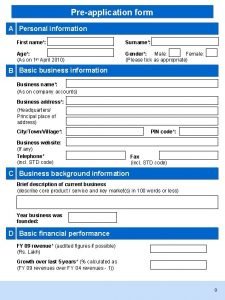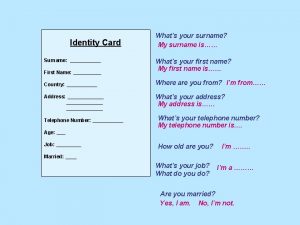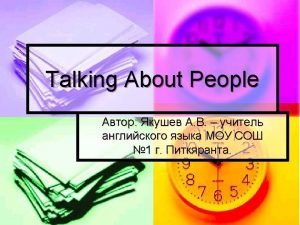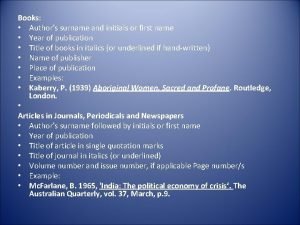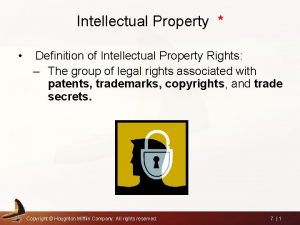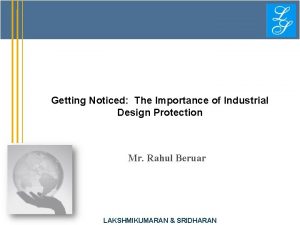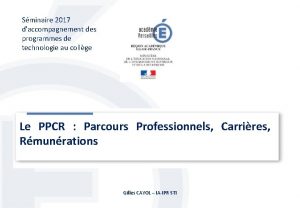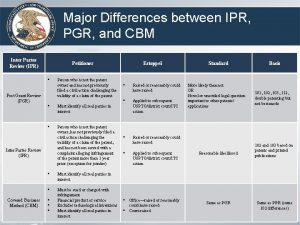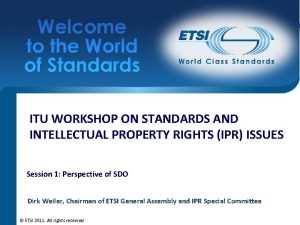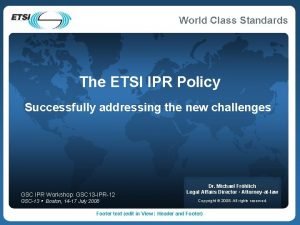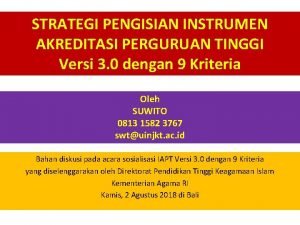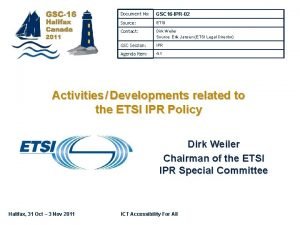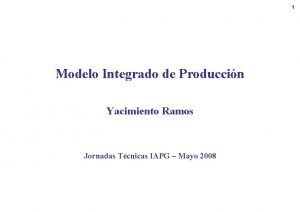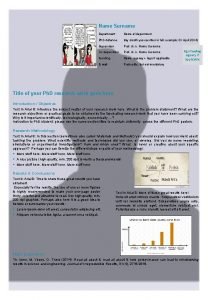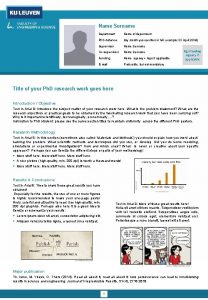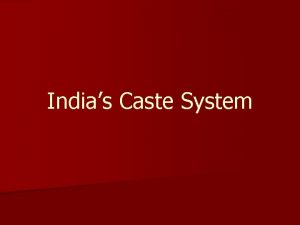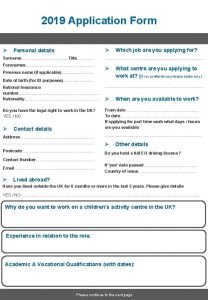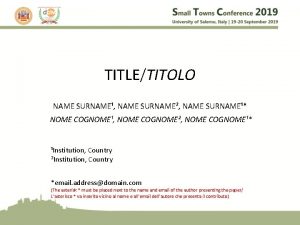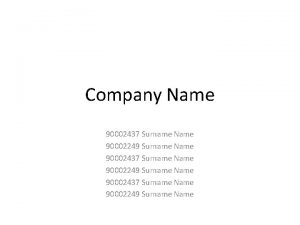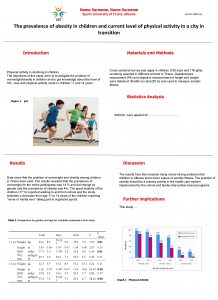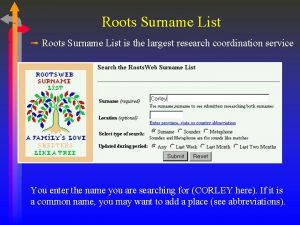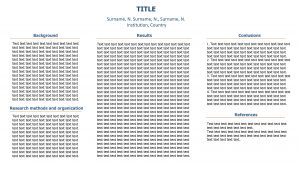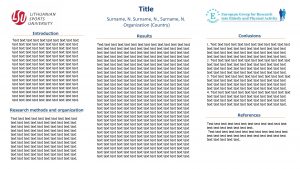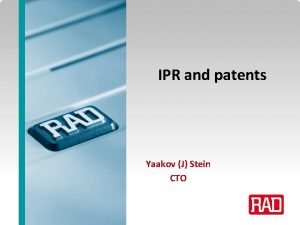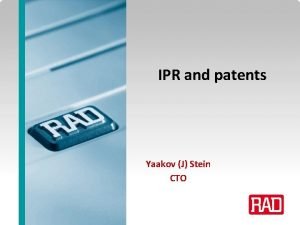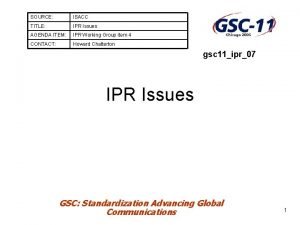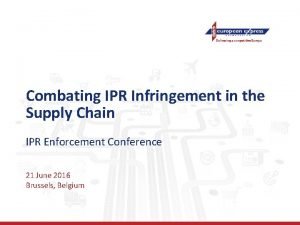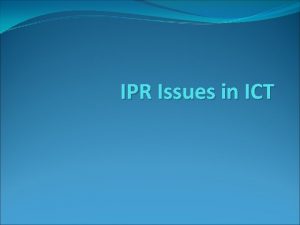Name Surname OmerLES International Legal Matters and IPR



















- Slides: 19

Name Surname Omer/LES International/ “Legal Matters and IPR”

Overview • • • Patents as a right Patent Litigation Trends The Business Case for IPR The America Invents Act IPR Features and Statistics Conclusions

The Patent Bargain • Patents are a private right. • Bargain between the public and the State. • A limited private monopoly in exchange for public benefits • Increasing the public storehouse of knowledge • …. • Controversy over too many lawsuits by patent trolls.

Background • Inter Partes Review was a newly created, yet controversial aspect of the US Patent system. • A response to the cost and volume of patent litigation, especially in the (Silicon Valley) tech sector. • This is a response to the Patent Troll phenomenon. • Industry heavily lobbied for a “better way”

Business Case for IPR • Rising Cost of Litigation for Operating Companies • Increased Scrutiny of socalled low quality patents • Limited ability to amend patents in a federal court • Rise of the “Patent Troll” • Argument for Greater Harmonization with other regimes with oppositions A White House press conference publicly supporting the need for patent reform.

Business Case for IPR • A key industry that argued for IPR was the smartphone sector. • This illustrated the thorny litigation in these “phone wars. ”

AIA: Landmark Patent Reform • In 2011, U. S. President Obama signed into law the America Invents Act (AIA). • The most sweeping change in US patent law in 50+ years. • It created the Inter Partes Review (IPR) system, Covered Business Method (CBM) review, and more.

• Patent Death Squads! Wall Street Journal, June 10, 2015 • IPR is controversial. • Called “Patent Death Squads” by Randall Rader, the former Chief Judge of the Court of Appeals for the Federal Circuit.

Key Features of IPR proceedings

Key Features of IPR Proceedings • Initiated by a Petition (and fee payment): – Formal recitations – Must identify all challenged claims and recite all grounds for review – 60 pages or less, 14 pt. font, double spaced • Must be accompanied by all supporting evidence – PTAB expects in most cases the evidence will include one or more expert declarations. – What does a reference disclose? What does the reference mean to a person skilled on the art? Why a feature in inherent in the prior art?

Key Features of IPR Proceedings Patent Owner (PO) Initial Response (optional): • • Decision to Initiate Proceedings • PO takes discovery of Petitioner’s Expert(s) • Patent Owner Response (with PO’s Expert Declarations) and Motion to Amend Claims (only one opportunity) • Petitioner takes discovery of PO’s expert(s). • Petitioner’s Reply (w/ rebuttal declarations) and Opposition to Amendments • PO discovery of rebuttal experts • PO’s Reply • Trial (Oral Hearing) ~~~~~> Final Written Decision

Major Differences between IPR, PGR, and CBM Inter Partes Review (IPR) Petitioner • Post Grant Review (PGR) • Person who is not the patent owner and has not previously filed a civil action challenging the validity of a claim of the patent Estoppel • Raised or reasonably could have raised • Applied to subsequent USPTO/district court/ITC action • Raised or reasonably could have raised Must identify all real parties in interest Standard More likely than not OR Novel or unsettled legal question important to other patents/ applications Basis 101, 102, 103, 112, double patenting but not best mode • Inter Partes Review (IPR) Covered Business Method (CBM) Person who is not the patent owner, has not previously filed a civil action challenging the validity of a claim of the patent, and has not been served with a complaint alleging infringement of the patent more than 1 year prior (exception for joinder) • Must identify all real parties in interest • • Must be sued or charged with infringement Financial product or service Excludes technological inventions Must identify all real parties in interest • Applied to subsequent USPTO/district court/ITC action • Office—raised or reasonably could have raised Court-raised • Reasonable likelihood Same as PGR 102 and 103 based on patents and printed publications Same as PGR (some 102 differences)

Major Differences between IPR, PGR, and CBM Proceeding Post Grant Review (PGR) Inter Partes Review (IPR) Covered Business Method (CBM) Available From patent grant to 9 months after patent grant or reissue For first-inventor-to-file, from the later of: (i) 9 months after patent grant or reissue; or (ii) the date of termination of any post grant review of the patent. For first-to-invent, available after grant or reissue (technical amendment) Available 9/16/12 (for first-inventor-tofile only after PGR not available or completed) Applicable Patent issued under first-inventor-to-file Patent issued under first-to-invent or first-inventor-to-file Patents issued under first-to-invent and first-inventor-to-file Timing Must be completed within 12 months from institution, with 6 months good cause exception possible

USPTO Statistics

USPTO Statistics

USPTO Statistics

USPTO Statistics

Conclusions • IPR builds on other traditions to challenge a patent outside the traditional court venue. • Offers advantages to parties, such as a lower cost. • IPRs are becoming very common in all patent infringement litigation. • Business need to revise their legal and business strategies. • The USPTO is still developing its IPR expertise, adding judges. • IPR was a controversial addition to the patent system, conflicting industry views. • IPR will not go away. It is part of the new normal.

Thank you LES International www. lesi. org
 First name surname
First name surname What s your surname
What s your surname First name surname
First name surname Author surname and initials example
Author surname and initials example European ipr helpdesk
European ipr helpdesk Intellectual property definition
Intellectual property definition Industrial design ipr
Industrial design ipr Grille indiciaire ia-ipr
Grille indiciaire ia-ipr Ipr vs pgr
Ipr vs pgr Etsi ipr database
Etsi ipr database Ipr cnc
Ipr cnc Etsi ipr database
Etsi ipr database Ipr dalam akreditasi
Ipr dalam akreditasi Etsi ipr database
Etsi ipr database Reservorios
Reservorios Name department
Name department Surname
Surname What's a surname
What's a surname Punjabi caste system
Punjabi caste system Surname in application form
Surname in application form
